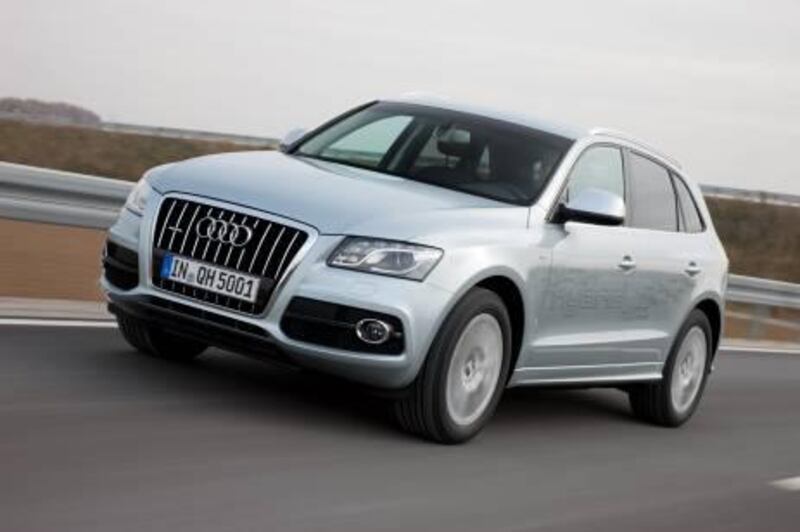The Q5 Hybrid is still officially a prototype (debuting in Geneva in March), but you'd hardly know it. The cabin is perfectly finished, the body has no rattles or squeaks and the fittings are pin-sharp.
This Q5 will be the first splash in a wave of electric and hybrid Audis to hit the streets in the coming years.
Its base engine is the 2.0L, direct-injection TFSI motor that's already available in everything from the A3 to the Q5 - Audi combines this with an electric motor up front, a lithium-ion battery pack down the back and all-wheel drive.
Audi has followed the recent German tradition of slotting the electric motor between the engine and the eight-speed automatic gearbox and using it to replace the torque converter. There's no starter because the electric motor does that job, along with generating 12-volt power to power up the a/c, water pump and power steering.
Audi is anticipating cities adopting "green zones" where you won't be able to drive on internal combustion power, so the Q5 Hybrid has a full electric mode using the 211Nm, 33kW electric motor.
But it won't take you far. The lithium-ion battery pack is, at 38kg, one of the lightest in the business, but it only has 72 cells and, at 266 volts, it can only store 1.3 kW/hr of energy. At full throttle in electric mode, that's measured in seconds, not minutes.
Audi insists it can hit 100kph as a pure electric car and, at a steady 60kph, the Q5 will run for 3km. On our test, that was only feasible when hills, lights and other drivers co-operated. Usually, the car's brain turned on the petrol motor far sooner.
The Sport mode sees the electric motor team up with the turbo petrol engine to add more urge to the surge on hard acceleration. This takes the car's output to 241hp and 480Nm, punching the Q5 to 100kph in 7.1 seconds and up to 222kph.
The standard Drive mode uses both motors to maximise efficiency, and Audi claims 7.0L/100km and 160 grams of CO2 on the combined cycle, not bad from 1,998kg.
The interesting thing here was not that the Q5 seemed production-ready, but that it seemed to fall down in its established knowhow.
The petrol, 2.0L turbo engine has been around for a while, but Audi changed some critical pieces and while it works strongly, its noise, vibration and harshness were unexpected. Disappointingly, this engine felt coarse, loud and booming at medium revs, then unwilling to push harder at higher rpm.
Hybrids need an imperceptible switch between electric power to petrol power, but the Q5's petrol motor gave a significant shudder when it fired up. It's possible that this was a quirk typical of a prototype, where different engines are thrown into different chassis for a host of reasons, but it must be addressed.The electric motor worked seamlessly though. It's quiet and the battery pack, sitting beneath the rear cargo floor, only takes away the under-floor space most people forget they have anyway.
It provides a driving challenge, too, because the motor turns into a generator when you ease off the throttle on downhills or brake lightly. This is when it recharges its batteries and Audi's got the brake pedal feel more consistent with normal braking systems than, say, Mercedes-Benz has with its S400H.
It's also quick when both motors are at work. The beauty of electric motors is that, while its 211Nm is significant, it provides that much turning force from the instant you touch the pedal. The petrol engine needs to wait until the engine revs build up to its torque peak; the electric doesn't and is like flicking a switch to "Maximum Torque".
The ride quality and interior are virtually unchanged, and the handling doesn't lose anything because there's the extra weight of the battery pack at the back balancing the electric motor up front.
Yet, while Audi needs to work on smoothing out the petrol engine and its restarting process, the real problem might be that the diesel A5 is more economical and the V6 petrol Q5 is faster. So what's the point? One point may be that this system slots neatly into Audi's new architecture, with a longitudinal engine layout up front and all-wheel drive, so it will fit the A6 and the A8 easily. It is expected to go on sale in Europe mid-year, and Audi Middle East may bring it to the UAE later this year.
The specs
Price, base / as tested n/a
Engine 2.0L turbocharged four cylinder plus electric motor
Gearbox eight-speed automatic
Power 245hp @ 5,000 rpm
Torque 480Nm @ 1,500 rpm
Fuel economy, combined 7L/100km






